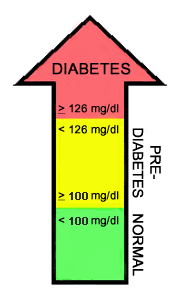Diabetes mellitus type 1 laboratory findings: Difference between revisions
No edit summary |
No edit summary |
||
| Line 2: | Line 2: | ||
{{Diabetes mellitus type 1}} | {{Diabetes mellitus type 1}} | ||
{{Diabetes mellitus}} | {{Diabetes mellitus}} | ||
Please help WikiDoc by adding more content here. It's easy! Click [[Help:How_to_Edit_a_Page|here]] to learn about editing. | |||
{{CMG}} | {{CMG}} | ||
Revision as of 15:26, 21 February 2013
|
Diabetes mellitus type 1 Microchapters |
|
Differentiating Diabetes mellitus type 1 from other Diseases |
|
Diagnosis |
|
Treatment |
|
Cardiovascular Disease and Risk Management |
|
Case Studies |
|
Diabetes mellitus Main page |
|
Patient Information |
|---|
Please help WikiDoc by adding more content here. It's easy! Click here to learn about editing.
Editor-In-Chief: C. Michael Gibson, M.S., M.D. [1]
Laboratory Findings
There are two different tests your doctor can use to determine whether you have pre-diabetes or diabetes: the fasting plasma glucose test (FPG) or the oral glucose tolerance test (OGTT). The blood glucose levels measured after these tests determine whether you have a normal metabolism, or whether you have pre-diabetes or diabetes. If your blood glucose level is abnormal following the FPG, you have impaired fasting glucose (IFG); if your blood glucose level is abnormal following the OGTT, you have impaired glucose tolerance (IGT).

FPG OGTT
The most useful laboratory test to distinguish Type 1 from Type 2 diabetes is the C-peptide assay, which is a measure of endogenous insulin production since external insulin (to date) has included no C-peptide. However, C-peptide is not absent in Type 1 diabetes until insulin production has fully ceased, which may take months. The presence of anti-islet antibodies (to Glutamic Acid Decarboxylase, Insulinoma Associated Peptide-2 or insulin), or lack of insulin resistance, determined by a glucose tolerance test, would also be suggestive of Type 1. As opposed to that, many Type 2 diabetics still produce some insulin internally, and all have some degree of insulin resistance.
Testing for GAD 65 antibodies has been proposed as an improved test for differentiating between Type 1 and Type 2 diabetes.